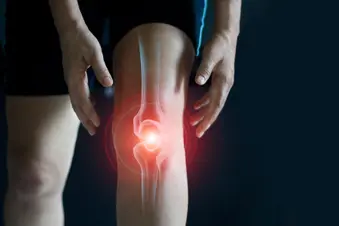

Cruising on the track in the heat of a roller derby match, 27-year-old Rachel Piplica was not at all prepared for the realization that her knee could sideline her from competitive skating for months, possibly years.
"Suddenly, I heard a pop and it felt like my knee bent sideways. The pain was so bad I just fell and crawled away," Piplica tells WebMD.
The Los Angeles fashion designer who skates under the name Iron Maiven tried to keep going. "I took one more stride and my knee just let go again. The doctor immediately said, 'I think you tore your ACL.'"
Piplica had experienced some warning signs during her previous season of skating as captain of her team, but she ignored them for the most part. "I had tremendous pain in my leg anytime I'd squat down so I just kept my right leg straight. But I never saw a doctor for it. I just assumed, 'I'm in a contact sport and this is what happens,'” she tells WebMD.
Knee deep: A complex and vulnerable joint
Her torn ACL diagnosis confirmed, Piplica quickly learned how susceptible the knees can be to injury. According to the American Academy of Orthopaedic Surgeons, these joints are responsible for sending nearly 15 million Americans to the doctor every year.
And it's not just athletes who suffer. Knee problems can happen to anyone.
"Because they're the main hinge between the ground and the rest of your body, the knees serve as your 'wheels' that get you around and allow you to be active,” says University of Pennsylvania orthopedic surgeon and sports medicine specialist Nicholas DiNubile, MD. "Life can really go downhill when you damage your knees,” says DiNubile, who is a spokesman for the American Academy of Orthopaedic Surgeons and author of FrameWork - Your 7-Step Program for Healthy Muscles, Bones and Joints.
Bound by an intricate system of ligaments, tendons, cartilage, and muscle, the knee is highly prone to injury. It's a complex hinge where the femur (thigh bone), tibia (shin bone), fibula (next to tibia) and kneecap all come together.
"It's hard to find the right balance between mobility and stability; the knee needs to move back and forth, twist a little, and pivot too,” DiNubile says. The knee's ligaments can tear, its tendons can swell up, osteoarthritis can take hold, and even everyday wear and tear can ruin a perfectly good set of knees.
Here are six pitfalls you can avoid to save your knees.
1. Ignoring knee pain.
An occasional ache here and there is common. "But knowing when you can and can't ignore pain is key,” says sports medicine specialist Jordan Metzl, MD, from the Hospital for Special Surgery in New York City.
Metzl's rule of thumb: When the pain limits your ability to do what you normally do, you need to have it checked out.
"If your body is sending you signals, you need to listen to them. If they persist, you need to have it checked out,” he tells WebMD.
For Piplica, exploratory surgery revealed a torn meniscus she had endured in the past -- unbeknownst to her -- followed by the more recent ACL tear.
"In hindsight, maybe that first injury could have been repaired earlier, although I don't know if I could have avoided this one altogether,” she says. "At least I would have been more careful."
2. Being overweight.
Every pound of body weight yields five pounds of force on the knee, so even 10 extra pounds can put a considerable load on those joints.
Being overweight also increases your chances of osteoarthritis in the knee, a common and often disabling form of arthritis that wears away the knee's cushiony cartilage. Excess pounds also cause existing arthritis to worsen more rapidly. According to the CDC, two out of three obese adults suffer from knee osteoarthritis at some time in their life.
Although diet and exercise are critical for weight loss, it's a double-edged sword.
"If your knees hurt, it's harder to lose weight through exercise,” says Metzl. So he recommends activities that go easy on the knee.
For example, opt for a stationary bike over running on the treadmill, and walk on a flat surface instead of hilly turf. If you're a die-hard treadmill fan, then go for longer sessions of walking punched with brief intervals of brisk walking or running every three to five minutes, DiNubile says.
3. Not following through with rehab and rest.
The rest and rehabilitation period after a knee injury is critical to avoiding future pain or reinjury. Depending on the type of damage and treatment, recovery could last anywhere from a couple of weeks to several months.
"During the rehab period, you need someone to help you tell the difference between something that just hurts, and something that's going to do you harm,” says DiNubile.
He tells WebMD that many of his young athlete patients are too eager to return to regular play as soon as they stop limping. He advises patients to work with an orthopedic surgeon, a sports medicine physician, a physical therapist, an athletic trainer, or some combination of these pros, in order to ensure proper focus is placed on gradually strengthening the knees.
4. Neglecting your ACL.
One of the most commonly injured ligaments in the knee, the anterior cruciate ligament (ACL) is responsible for about 150,000 injuries in the U.S. every year.
As Piplica learned firsthand, sports like roller derby that involve quick cuts, twists, and jumping, put the ACL at higher risk for rupturing. More traditional high-risk sports include soccer, basketball, football, and volleyball.
Women in particular have a two- to eight-times higher risk for ACL tears compared to men, mainly because the way women naturally jump, land, and turn puts greater strain on the ACL.
However, male and female athletes alike can be trained to "rewire” themselves and thus lower risks of knee injury. That's done through neuromuscular training, which involves supervised practice in improving agility, leg strength, and jump-landing techniques for better knee joint stability.
These specialized techniques are effective in reducing risks of knee injury by almost one-half, according to a 2010 review of seven neuromuscular training studies.
"Given what we know in how useful it can be in reducing ACL tears, it's irresponsible of coaches and parents to not require athletes to undergo neuromuscular training,” says DiNubile.
He recommends that athletes of any age who play ACL risk-prone sports should seek help from an athletic trainer or other trained professional to help avoid this debilitating injury.
5. Overdoing it.
"You make gains in fitness when you work hard and then allow your body to recover. You can't do a hard workout every day," Metzl says.
A sudden increase in intensity or duration of exercise can cause overuse injuries from repetitive strain. Tendonitis and kneecap pain are common symptoms in the knee.
Pushing too hard is also related to overtraining syndrome, a physiological and psychological condition among athletes in which they exceed their ability to perform and recover from physical exertion, often leading to injury or lowered performance.
Be sure to include stretching exercises before and after working out. And follow hard training days with easy ones so your body can recover.
6. Overlooking other muscles around the knees.
Weak muscles and lack of flexibility are primary causes of knee injuries, according to the Mayo Clinic. When the muscles around the kneecap, hip, and pelvis are strong, it keeps the knee stable and balanced, providing support by absorbing some of the stress exerted on the joint.
DiNubile stresses the importance of building the quadriceps and hamstring muscles, as well as proper strengthening of the body's core muscles, including the obliques, lower back muscles, and upper thigh.
His favorite tool to help accomplish this strengthening is a Swiss medicine ball. Other exercises to try are knee extensions, hamstring curls, leg presses, and flexibility exercises.
Piplica recalls realizing just how weak some of her leg muscles were.
"Roller girls are striding out so much with their outer leg muscles, but we aren't necessarily working our inner knees," she says. "I remember when I would run for exercise, my calves and shins would hurt so bad. That surprised me, because I thought if anything was strong, it was my legs.”
Piplica says she wishes she had been better educated about crosstraining activities for roller skaters, and what muscle groups they need to focus on to keep their knees healthy.
As she awaits surgery to repair her torn ACL, Piplica tells WebMD that her perspective on long-term care for her knees has definitely changed.
"Half of me is frustrated about not being able to skate sooner, but the other half knows how important it is to get better so I don't do this again. I'm 27 years old with a serious knee injury preventing me from moving around. So I need to look beyond just skating, skating, skating. I don't want to have knee problems when I'm 40 or 50 because I'm not giving my body the kind of attention it needs right now."
Show Sources
Photo Credit: ipopba / Getty Images
SOURCES:
Hubscher, M. Medicine & Science in Sports & Exercise, March 2010; vol 42: pp 413-421.
Johnson, M. Journal of Athletic Training, 1992; vol 27: pp 352-354.
Prodromos, C. Arthroscopy, December 2007; vol 23: pp 1320-1325.
Nicholas DiNubile, MD, spokesman, American Academy of Orthopaedic Surgeons; clinical assistant professor, Department of Orthopaedic Surgery, Hospital of the University of Pennsylvania.
Jordan Metzl, MD, sports medicine specialist, associate attending physician, Hospital for Special Surgery.
American Academy of Family Physicians: Running: Preventing Overuse Injuries.
American Academy of Orthopaedic Surgeons.
American Orthopaedic Society for Sports Medicine: Anterior Cruciate Ligament (ACL) Injury Prevention.
CDC.
Cleveland Clinic: "Protecting Your ACL."
Mayo Clinic: "Knee Pain."